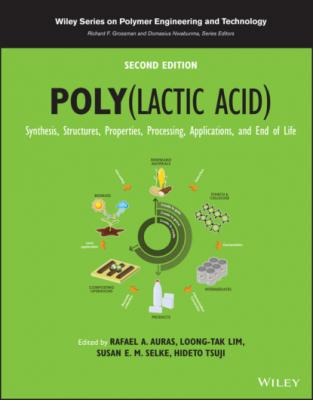Poly(lactic acid). Группа авторов
Чтение книги онлайн.
Читать онлайн книгу Poly(lactic acid) - Группа авторов страница 22
 range of tailor‐made polylactides by continuous melt polymerization processes, like the technology based on static mixing reactors that was jointly developed by Sulzer and PURAC.
range of tailor‐made polylactides by continuous melt polymerization processes, like the technology based on static mixing reactors that was jointly developed by Sulzer and PURAC.
PLA offers an unprecedented market potential to lactic acid producers all over the world, but not all potential players can succeed, because PLA production poses stringent demands to lactic acid quality and price. The chemistry and physics of today's fermentative production and industrial‐scale purification of lactic acid and lactide are the subject of this chapter.
1.2 LACTIC ACID
1.2.1 History of Lactic Acid
Lactic acid was discovered in 1780 by the experimental chemist Carl Wilhelm Scheele, who isolated “acid of milk” from sour whey [12, 13]. A further description of the history of lactic acid by Holten and Benninga shows that industrial production of lactic acid started in the United States in the 1880s [14, 15]. Avery patented and applied a process of fermentation of vegetable sugars [16]. The actual application was the use of a mixture of calcium lactate and lactic acid as baking powder. Unfortunately, this application was not a big success, but other applications in food and textile dyeing were developed.
FIGURE 1.1 Two enantiomeric forms of lactic acid: (S)‐ and (R)‐2‐hydroxypropionic acid.
In 1950, the first commercial production of synthetic lactic acid started in Japan [15]. Lactonitrile was produced from acetaldehyde and hydrogen cyanide and hydrolyzed in the second stage to lactic acid. For some decades, synthetic lactic acid competed with lactic acid obtained by fermentation, but currently almost all lactic acid is produced by fermentation.
1.2.2 Physical Properties of Lactic Acid
Lactic acid (2‐hydroxypropanoic acid) is the simplest 2‐hydroxycarboxylic acid (or α‐hydroxy acid) with a chiral carbon atom and exists in two enantiomeric forms (Figure 1.1).
The chirality of lactic acid often results in confusion regarding nomenclature. A number of different names are used in the literature. This confusion is the result of mixing the molecular structure and a physical property (optical rotation). (S)‐Lactic acid (or L‐lactic acid) has a slightly positive‐specific optical rotation and is frequently named L‐(+)‐lactic acid [14]. However, a concentrated solution of (S)‐lactic acid at equilibrium contains lactic acid oligomers, which results in an overall negative optical rotation. Therefore, it is advised to use the structural R/S notation or the older notation of L and D and avoid the + and − of the optical rotation (Table 1.1).
1.2.3 Chemistry of Lactic Acid
The lactic acid molecule has a hydroxyl and an acid functional group, which may result in intermolecular and intramolecular esterification reactions. The first step is the formation of a linear dimer (lactoyl lactic acid). This condensation reaction can proceed to higher oligomers and is promoted by removal of water. Also a cyclic dimer, lactide, is formed in small amounts. Lactide can be formed by intramolecular esterification of lactoyl lactic acid or by breakdown of higher oligomers. All reactions are equilibrium reactions (Figure 1.2).
Due to these reactions, a solution of lactic acid at equilibrium consists of monomeric lactic acid, dimeric lactic acid or lactoyl lactic acid, higher oligomers of lactic acid, and lactide. The ratios between all substances depend on the amount of water present; for example, a 90.1% lactic acid solution (total acidity) contains about 59.3% of monomeric lactic acid and 27.3% of lactoyl lactic acid and higher oligomers [14].
TABLE 1.1 Physical Properties of Lactic Acid [14]
| Property | Value | Reference |
|---|---|---|
| CAS number | General: 50‐21‐5 | — |
| (S)‐Lactic acid: 79‐33‐4 | — | |
| (R)‐Lactic acid: 10326‐41‐7 | — | |
| Molecular weight (g/mol) | 90.08 | — |
| Formula | C3H6O3 | — |
| Melting point (°C) | 18 (racemic) | [17] |
| 53 (chiral pure) | [18] | |
| Crystal structure | (S)‐Lactic acid: orthorhombic, space group P212121 | [19] |
| Solid density (g/mL) | 1.33 (solid, 20°C) | [20] |
| Solubility in water (wt%) | 86 (20°C, monomeric (S)‐lactic acid) | [20] |
| Heat of fusion (kJ/mol) | (S)‐Lactic acid: 16.8 | [21] |
| Boiling point (°C) | 122 (at 14 mmHg) | [22] |
| Liquid density (g/mL, 20°C) | 1.224 (100% undercooled liquid) | [22] |
| 1.186 (80.8% solution in water) | [23] | |
| Viscosity (mPa s) | 28.5 (85.3% solution in water, 25°C) | [23] |
| pK a | 3.86 | [24] |
| Specific heat (J/(g K) at 25°C) | Crystalline (S)‐lactic acid: 1.41 | [25] |
| Liquid lactic acid: 2.34 | [26] |
The condensation reactions are also the reason that it is quite difficult to obtain pure, solid, and enantiopure lactic acid. This can only be achieved by crystallization [27, 28]. The kinetics of the condensation reactions determine the stability of a solution of monomeric lactic acid and have a large influence on the stability of solid lactic acid.
1.2.4 Production of Lactic Acid by Fermentation
Almost